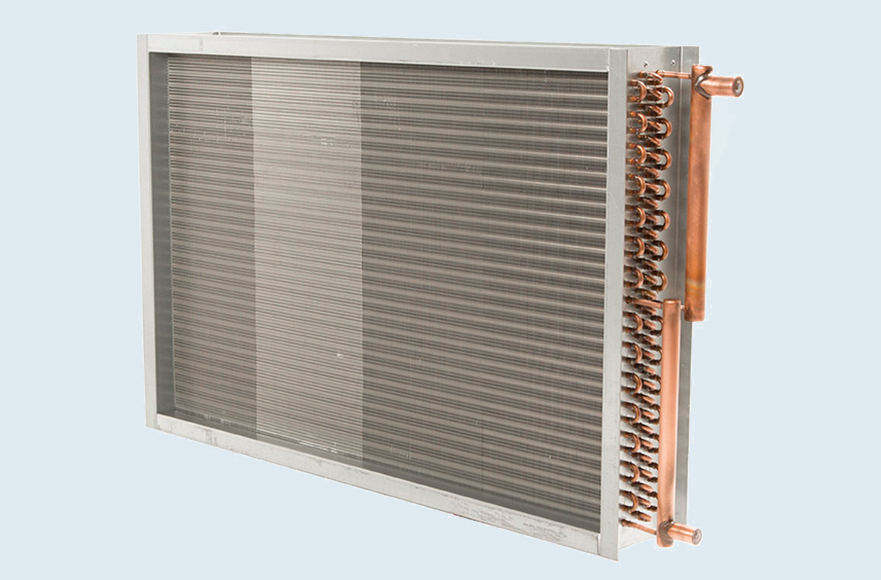Understanding Condenser Coil Vibration

There are many packaged HVAC unitary products that have condenser coils as an integral part of the unit’s design. They include:
- Indoor air-cooled, self-contained air handlers
- Outdoor air-cooled condensers
- Outdoor air-cooled condensing units
- Packaged outdoor rooftop air handlers
All the above types of units have been staples in our industry for over 50 years. Air-cooled condenser coils are usually on the perimeter of these units, but many are now placed at angles inside the unit with top discharge condenser fans. We have been replacing these coils since the early 70’s, and we have found that the two main culprits that create condenser coil vibration are either 1) plugging of coils via dirt or corrosion or 2) excess vibration. The following clarifies how vibration can destroy condenser coils over time.
Industry designs have condenser coils very close to the condenser fans, which are almost always propeller type. Some fans are belt driven and some are direct drive type. Many designs have fans running at more than 1200 RPM. When fans run above 1500 RPM, they create noise problems; therefore, most manufacturers will not have the fans and motors turning higher than 1500 RPM. Most of today’s designs are direct drive due to cost and parts issues. When a unit package includes a compressor(s), they are almost always close to the condenser simply because they function just before the condenser coils in the refrigeration cycle. Now we have two operating and vibrating parts running very close to the condenser coils.
Excess vibration damage to coils is nothing more than enough vibration to cause “wear holes” in the coil tube sheets and intermediate tube sheets down the length of the coil. Can you tell if there is excess vibration on a unit? Probably not! The radiating vibration from the moving equipment runs through structural supports and component interconnecting piping. This vibration is usually not sufficient for a visual observation to confirm that it’s high enough to be causing condenser coil failures.
You might not know that most vibration problems are caused by an inadequate design of the unit by the manufacturer. All HVAC manufacturers want to keep their products light in weight and to the smallest dimensions, because weight and size have a lot to do with shipping costs and installation costs. Due to the very competitive nature of our industry, design engineers are always cost conscious and strive to create energy efficient units that are light in weight and small in size. This is when design flaws can come into play.
The condenser fans run inside a shrouded area and are reinforced by the structure of the unit. Often, this reinforcement and paneling are so light that the vibration from these fans radiates down into the condenser coil. Many times, you can visually see that the condenser coils are only inches away from this rotating equipment. This vibration can be such that we have seen holes in tube sheets within the warranty period. We have also seen it happen in two or three years. Remember that holes in the tube sheet are almost always vibration related.
Fan/motor combinations also change over time. They can begin to run “rough” (out of balance), which also leads to excess vibration. We have seen many systems experience leak-free coils for eight years with a massive number of leaks in years nine and ten. It’s thought that the coils need replacement, without realizing that there is excess vibration now that didn’t exist previously. If the coils are changed without fixing the vibration problem, the new coils won’t last very long in this system.
Vibrating compressor(s) can also cause leaks at condenser coil tube sheets. Many times, it’s either the cumulative vibration from a close-proximity coil(s) or the compressor(s) that increases the vibration over time. The vibration is then radiated through the hot gas line into the hot gas header of the condenser coils. Note that the hot gas header on a condenser coil(s) has more expansion and contraction. Along with the vibration, this can create problems at the tube sheet behind this incoming coil header.
If condenser fans are the reason for condenser coil failures, a structural engineer must review this structure at or near the fans and reinforce the area to reduce the radiating vibration into the condenser coils. If it’s found to be a compressor(s), then vibration isolation under the compressor and vibration line eliminators in the hot gas line might be appropriate.
Again, holes in tube sheets are because of excess vibration. There is no other reason. It’s important to understand that the elimination of said vibration will allow condenser coils to have a much longer life span.
TIP OF THE DAY
Southwest Coil has been replacing coils since the early 70’s. We have found that coils are replaced prematurely because of an application or system-oriented problem that went undiagnosed. We are here to assist you every step of the way – not replace a problem with a new problem. Call or email us. With our knowledge and working experience, our Sales Engineers can diagnose the problem and replace the coil(s) with confidence that you will achieve maximum longevity with your new purchase.


